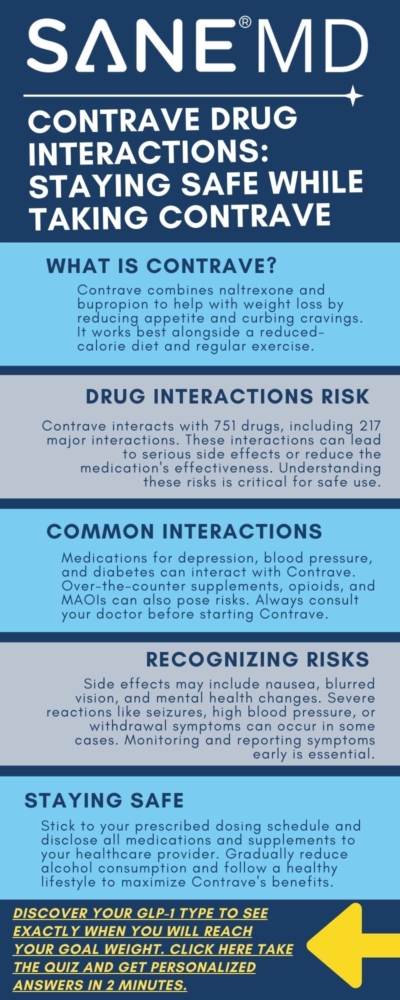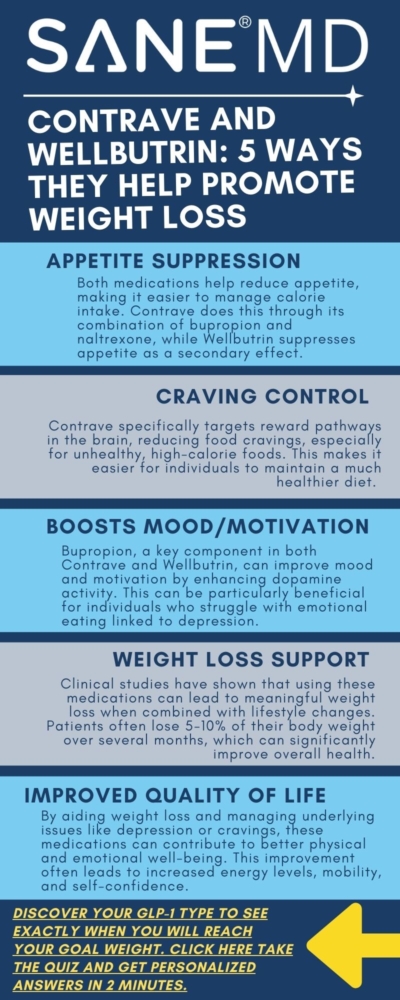Contrave Drug Interactions: A Complete Guide to Safe Use
Contrave is a prescription medication combining naltrexone and bupropion, designed to assist in weight loss by targeting the brain’s hunger and reward systems. While effective for many, understanding Contrave drug interactions is crucial to ensure safe and effective use. With 751 known drug interactions—including 217 major, 529 moderate, and 5 minor interactions—it’s essential to consider how this medication may interact with prescription drugs, over-the-counter medications, or supplements. These interactions can lead to unwanted side effects or reduced effectiveness.
This guide explores everything you need to know about Contrave drug interactions, including how to avoid risks, manage potential side effects, and safely integrate this medication into your weight-loss journey.
Key Takeaways
- Multiple Interactions: Contrave interacts with several drugs, including antidepressants, blood pressure medications, and certain over-the-counter supplements.
- Conditions and Risks: Certain medical conditions, such as liver disease, seizure disorders, and mental health conditions, increase the risk of side effects when taking Contrave.
- Precautionary Measures: Always consult with a healthcare provider, follow the medication guide, and disclose all medications and supplements to avoid potentially serious complications.
How Contrave Works
Contrave is a combination of naltrexone hydrochloride and bupropion hydrochloride.
- Naltrexone: Commonly used for treating opioid withdrawal and alcohol dependence. It helps reduce cravings.
- Bupropion: Used to treat depression and aid smoking cessation. It helps suppress appetite.
Together, these ingredients target the brain’s hunger centers, promoting weight loss when combined with a reduced-calorie diet and exercise. Vist our comprehensive guide for more information about how Contrave works for weight loss.
Mechanism of Action
The dual-action mechanism works by:
- Reducing Cravings: Naltrexone alters the brain’s reward system to decrease the desire for food and unhealthy eating habits.
- Suppressing Appetite: Bupropion helps regulate dopamine and norepinephrine levels, leading to decreased hunger and improved mood.
- Enhancing Lifestyle Changes: Contrave’s effectiveness increases when combined with lifestyle modifications like diet and exercise.
Contrave also targets regions of the brain linked to emotional eating, making it particularly beneficial for compatible individuals who struggle with cravings triggered by stress or anxiety.
Why Contrave Drug Interactions Matter
Drug interactions can occur when Contrave is taken with other medications, leading to unwanted side effects or reduced efficacy.
For example, Contrave can increase blood pressure or the risk of seizures, especially when combined with certain drugs or medical conditions.
Common Risks from Drug Interactions:
- Increased Risk of Side Effects: Some interactions can lead to trouble sleeping, skin reactions, or more severe issues like heart attack or seizure disorder.
- Reduced Effectiveness: Contrave’s ability to aid weight loss may diminish when combined with conflicting drugs.
- Serious Complications: In rare cases, interactions can result in life-threatening conditions such as serious allergic reactions or severely high blood pressure.
Medications That Interact with Contrave
| Medication Type | Examples | Interaction with Contrave | Potential Risks |
|---|---|---|---|
| Antidepressants | SSRIs (e.g., fluoxetine) | Increases risk of seizures or serotonin syndrome | Nausea, confusion, seizures |
| Blood Pressure Medications | Beta-blockers, ACE inhibitors | May require monitoring or dosage adjustments | Irregular heartbeat, increased blood pressure |
| Diabetes Medications | Insulin, metformin | Alters blood sugar levels | Risk of low blood sugar (hypoglycemia) |
| Opioid Medications | Oxycodone, morphine | Naltrexone blocks opioid effects, triggering withdrawal symptoms | Ineffective pain management, withdrawal symptoms |
| MAOIs | Phenelzine, tranylcypromine | Contraindicated; discontinue 14 days before starting Contrave | High blood pressure, severe side effects |
| Over-the-Counter Drugs | Pain relievers, diet pills | Can increase seizure risk or blood pressure | Dizziness, nausea, dangerously high blood pressure |
Medications That Interact with Contrave
Antidepressants
Contrave can interact with selective serotonin reuptake inhibitors (SSRIs) and other antidepressants, increasing the risk of seizures or serotonin syndrome.
Patients with existing mental health conditions should consult their healthcare provider to assess the safety of combining these medications.
Blood Pressure Medications
Contrave is not recommended for individuals with uncontrolled high blood pressure as it can further increase blood pressure or lead to irregular heartbeat.
Patients on medications for hypertension should have their blood pressure monitored regularly and may require dosage adjustments.
Diabetes Medications
Contrave can affect blood sugar levels, particularly for those taking insulin or other diabetes drugs.
Monitor for symptoms of low blood sugar, such as dizziness or confusion, and report any unusual changes to your healthcare provider.
Opioid Medications
Because Contrave contains naltrexone, it blocks the effects of opioids. Taking opioids while on Contrave can trigger withdrawal symptoms or reduce the effectiveness of pain medications.
Patients prescribed opioid medications should discuss alternative options with their doctor before starting Contrave.
Monoamine Oxidase Inhibitors (MAOIs)
MAOIs, often used to treat depression, must be discontinued at least 14 days before starting Contrave due to an increased risk of side effects, including high blood pressure and severe interactions.
Anti-Convulsants
Combining Contrave with anti-convulsant medications can lead to serious interactions. For example, taking Contrave and Topamax together can increase the risk of seizures, even in those who do not have a seizure disorder.
Over-the-Counter Medications and Supplements that Interact with Contrave
Common OTC Interactions
Over-the-counter medications, including pain relievers, decongestants, and diet pills, can increase the risk of seizures or seriously high blood pressure when combined with Contrave.
Even seemingly harmless medications like antihistamines or sleep aids may pose risks.
Supplements and Vitamins
While rare, vitamin interactions can occur. Certain supplements, especially those marketed for weight loss or energy enhancement, may conflict with Contrave’s effects.
Always disclose any supplements to your healthcare provider to identify possible interactions.
Lifestyle Modifications with Contrave
Contrave works best when combined with significant lifestyle changes. These include:
Diet
Following a reduced-calorie diet that prioritizes whole foods over processed options.
High-fiber foods can enhance satiety, while avoiding high-fat meals reduces the risk of nausea.
Exercise
Regular physical activity, such as 30 minutes of moderate exercise five days a week, helps maximize weight loss and improves cardiovascular health.
Behavior Changes
Incorporating mindful eating practices and stress management techniques to address emotional eating triggers.
Contrave and Specific Medical Conditions
Liver and Kidney Disease
Contrave is contraindicated for individuals with end-stage kidney disease or significant liver disease due to increased drug accumulation and heightened risk of side effects.
Patients with mild to moderate kidney disease should be closely monitored while taking Contrave.
Mental Health Conditions
People with bipolar disorder or other mental health conditions may experience worsened symptoms, such as suicidal thoughts or mental health changes.
Open communication with a healthcare provider is essential to weigh the risks and benefits of treatment.
Eating Disorders
Individuals with a history of eating disorders should avoid Contrave due to the heightened seizure risk.
This includes conditions such as bulimia nervosa and anorexia nervosa, where fluctuations in electrolytes may exacerbate risks.
Diabetes
Contrave’s ability to affect blood sugar levels requires careful monitoring for those managing diabetes. Adjustments in diabetes medication dosage may be needed to avoid low blood sugar episodes.
Benefits and Risks of Contrave Treatment
Benefits
- Effective Weight Loss: When combined with lifestyle changes, Contrave can lead to significant reductions in body weight for certain individuals.
- Appetite Control: Helps reduce food cravings, especially for high-calorie foods.
- Improved Quality of Life: Many patients report better mood and energy levels.
Risks
- Increased Risk of Side Effects: Common side effects include nausea, dizziness, and trouble sleeping.
- Severe Reactions: Rare cases of serious allergic reaction, dark urine, or liver issues require immediate medical attention.
- Drug Interactions: Patients on multiple medications need to carefully manage possible interactions.
Comparing Contrave to Other Weight-Loss Medications
Wegovy and Ozempic
Wegovy and Ozempic, both based on the active ingredient semaglutide, are part of a class of medications called GLP-1 receptor agonists.
These drugs primarily focus on regulating blood sugar levels and suppressing appetite by mimicking a hormone that signals fullness to the brain.
- Delivery Method: These medications are injectable, which may be a deterrent for individuals who prefer oral medications like Contrave. However, the once-weekly dosing schedule for semaglutide-based medications offers convenience for those willing to use injections.
- Suitability for Diabetes: Wegovy and Ozempic are particularly beneficial for individuals managing type 2 diabetes due to their dual effect on weight loss and blood sugar control. For non-diabetic patients, they are prescribed off-label or through specific approvals for weight management.
- Efficacy: Clinical trials have shown that semaglutide can result in more significant weight loss compared to other medications. However, common side effects include nausea, vomiting, and potential long-term risks such as thyroid tumors.
Phentermine
Phentermine is a stimulant that acts as an appetite suppressant by affecting the central nervous system.
It is often prescribed for short-term use (typically a few weeks) to jumpstart weight loss.
- Speed of Results: Phentermine delivers rapid results, making it appealing for individuals seeking immediate weight loss benefits. However, its effects diminish over time, and it is not designed for long-term use.
- Dependency Risks: As a controlled substance, phentermine carries a risk of dependency and abuse. It is typically unsuitable for individuals with a history of substance misuse or certain medical conditions like high blood pressure or heart disease.
- Side Effects: Common side effects include insomnia, dry mouth, and trouble sleeping, which can make it challenging for some patients to tolerate.
While both medications aid in weight loss, they work through different mechanisms—phentermine is a stimulant-based appetite suppressant, and Contrave addresses cravings and emotional eating. If you’re considering which option may be better for you, read our in-depth comparison in Contrave vs. Phentermine.
Contrave
Contrave stands out as a unique option because it combines two active ingredients, naltrexone and bupropion, to address both cravings and emotional eating.
- Comprehensive Approach: Unlike Wegovy and Ozempic, which primarily regulate appetite through physiological mechanisms, Contrave addresses psychological factors like stress-related cravings. This makes it particularly beneficial for compatible individuals who struggle with overeating triggered by emotions.
- Oral Administration: Contrave is taken in pill form, which many patients find more convenient than injectable medications. The structured dosing schedule allows for gradual adjustments to minimize side effects.
- Broader Appeal: While semaglutide-based medications are highly effective for diabetes-related weight loss, Contrave is a more general option, targeting individuals who do not necessarily have underlying metabolic disorders.
- Side Effects and Risks: Like phentermine, Contrave carries risks, including an increased risk of side effects like nausea and suicidal thoughts. However, it lacks the dependency potential of phentermine, making it safer for long-term use in many cases.
Choosing the Right Medication
The choice between Contrave, Wegovy, Ozempic, and Phentermine depends on individual needs, medical history, and lifestyle preferences.
Factors like ease of use, underlying health conditions (e.g., diabetes or heart disease), and personal weight-loss goals should be carefully considered in consultation with a healthcare provider.
Each medication offers unique advantages, but understanding these distinctions ensures an informed and personalized treatment plan.
Real-World Tips for Using Contrave Safely
Taking Contrave requires careful adherence to best practices to ensure both safety and effectiveness.
Here’s a deeper dive into practical strategies that can help you get the most out of your treatment while minimizing risks:
Monitor Your Symptoms
Regularly monitoring your physical and mental health is essential while taking Contrave.
This medication can cause side effects ranging from mild to severe, and recognizing these changes early can prevent complications.
- Physical Symptoms: Keep an eye out for blurred vision, nausea, dizziness, or fatigue. These are common initial side effects that often diminish as your body adjusts, but if they persist or worsen, inform your healthcare provider.
- Mental Health Changes: Since Contrave contains bupropion, which can influence mood, it’s crucial to be alert to symptoms such as suicidal thoughts, heightened anxiety, or mood swings. If you experience any concerning changes in mental health, seek immediate medical attention.
- Tracking Progress: Maintaining a journal of any side effects or improvements can help you and your doctor adjust the treatment plan as needed. Note specific instances of trouble sleeping, skin reactions, or appetite changes.
Stick to a Schedule
Consistency is key when taking Contrave to maximize its effectiveness.
Skipping doses or taking the medication irregularly can interfere with its ability to support weight loss and increase the risk of side effects.
- Follow Prescribed Guidelines: Contrave is typically introduced in a gradual dosage schedule to help your body adapt. Missing doses can disrupt this process and lead to more pronounced side effects.
- Set Reminders: Use alarms, mobile apps, or pill organizers to ensure you take your medication at the same time each day. Creating a routine can make adherence easier, especially for those with busy schedules.
- Handle Missed Doses Correctly: If you miss a dose, do not double up on your next one. Taking more than the recommended dose can increase the risk of seizures or other complications. Instead, resume your normal schedule and consult your doctor if you frequently forget doses.
Avoid Alcohol
Alcohol can interfere with Contrave’s effectiveness and increase the likelihood of adverse reactions.
It’s especially important to avoid suddenly stopping alcohol intake, as this can lead to withdrawal symptoms that amplify the medication’s side effects.
- Gradual Reduction: If you consume alcohol regularly, work with your doctor to create a plan for tapering down your intake. Abruptly stopping while on Contrave can increase the risk of seizures, especially in individuals with a history of heavy drinking.
- Understanding Risks: Drinking alcohol while on Contrave can exacerbate common side effects like dizziness and nausea. It can also impair your judgment, making it harder to follow the lifestyle changes needed for effective weight loss.
- Alternative Choices: Replace alcoholic beverages with non-alcoholic options, such as sparkling water or herbal teas, to make the transition easier and reduce cravings.
Communicate Openly
Transparency with your healthcare provider is crucial when taking Contrave.
The more information you share, the better equipped your doctor will be to help you avoid complications and tailor your treatment plan.
- Disclose All Medications: Include over-the-counter drugs, supplements, and vitamins in your list. Some possible interactions with Contrave, such as with opioids, antidepressants, or diet pills, can lead to severe side effects.
- Discuss Lifestyle Changes: Inform your doctor about your diet, exercise routine, and alcohol consumption. These factors can affect how Contrave works in your body and whether any adjustments are needed.
- Report Changes Promptly: Even minor symptoms like trouble sleeping, unusual tiredness, or blurred vision can indicate the need for intervention. Keep your doctor informed of all developments, no matter how small they seem.
Additional Tips for Safe Use
- Stay Hydrated: Drinking plenty of water can help alleviate some common side effects of Contrave, such as dry mouth and nausea. It also supports overall health and aids in the weight-loss process.
- Adopt a Balanced Diet: Pair Contrave with a reduced-calorie diet that prioritizes whole foods. Avoiding high-fat meals not only reduces nausea but also enhances the medication’s effectiveness.
- Monitor Weight and Progress: Track your weight-loss journey and share milestones or concerns with your healthcare provider. This can help determine whether adjustments to your dosage or treatment plan are necessary.
- Know When to Stop: If Contrave isn’t producing noticeable results after 12-16 weeks of consistent use, discuss alternative options with your doctor. Continuing ineffective treatment can expose you to unnecessary risks without benefits.
By following these real-world tips, you can ensure that Contrave remains a safe and effective part of your weight-loss journey.
Always remember that open communication and adherence to medical advice are your best tools for success.
FAQs About Contrave Drug Interactions
1. What medications should you not take with Contrave?
You should avoid taking Contrave with opioids, MAOIs, and certain antidepressants due to an increased risk of side effects or severe drug interactions.
Medications that lower the seizure threshold or increase blood pressure should also be avoided unless directed by a healthcare provider.
Always consult your doctor about all medications you’re taking to identify potential conflicts.
2. Who shouldn’t take Contrave?
Contrave is not recommended for individuals with a history of seizure disorders, uncontrolled high blood pressure, or eating disorders. Those with liver disease, bipolar disorder, or currently using opioid-based painkillers should also avoid Contrave.
Pregnant or breastfeeding women and individuals under 18 should not use this medication.
3. What can you not eat on Contrave?
While there are no strict dietary restrictions, avoiding high-fat meals is recommended as they can increase the absorption of the medication, potentially leading to side effects like nausea.
Focus on a reduced-calorie diet with balanced nutrients to enhance the medication’s effectiveness.
4. What is better than Contrave for weight loss?
The best weight-loss treatment depends on individual health factors.
Alternatives like Wegovy, Ozempic, or non-pharmaceutical approaches such as structured diet and exercise programs may be more suitable for some individuals.
Consulting a healthcare provider is essential to determine the best option based on your medical history and goals.
5. Can you take Contrave with blood pressure medication?
You can take Contrave with certain blood pressure medications, but monitoring is necessary. Contrave may increase blood pressure, so adjustments to your hypertension treatment plan may be required.
Always consult your doctor before combining these medications.
6. What is the downside of Contrave?
Potential downsides include an increased risk of side effects such as nausea, trouble sleeping, and suicidal thoughts.
Individuals with certain medical conditions or taking conflicting medications may experience severe complications, making it unsuitable for everyone.
7. What not to take while on Contrave?
Avoid taking opioids, diet pills, and MAOIs while on Contrave.
Over-the-counter medications and supplements marketed for energy or weight loss should also be approached with caution, as they may lead to possible interactions.
8. Who shouldn’t take Contrave?
Individuals with uncontrolled high blood pressure, a history of seizure disorder, or active mental health conditions like bipolar disorder should not take Contrave.
It is also contraindicated in those with end-stage kidney disease or liver dysfunction.
9. Does Contrave cause dependency or withdrawal symptoms?
Contrave does not cause dependency as it is not a controlled substance. However, stopping the medication abruptly may result in mild withdrawal-like symptoms, particularly for those sensitive to mood changes.
Gradual discontinuation under a doctor’s guidance is recommended.
10. How long does it take to see results with Contrave?
Patients may start noticing changes within the first 4-8 weeks, especially when paired with diet and exercise. Significant weight loss typically occurs after 12-16 weeks of consistent use.
If no progress is made, consult your doctor about adjusting the treatment plan.
Conclusion
Understanding and managing Contrave drug interactions is key to ensuring its safe and effective use for weight loss. Always disclose your full medical history, including other medications, supplements, and health conditions, to your doctor.
With proper precautions and monitoring, Contrave can be a valuable tool in achieving weight-loss goals.
Contrave and Wellbutrin: How They Help Promote Weight Loss
Weight management remains a critical health priority for many individuals, especially those grappling with obesity and its associated risks. Medications like Contrave and Wellbutrin have emerged as potential tools to aid weight loss efforts.
This article explores how these medications function, their benefits, and the considerations surrounding their use.
Key Takeaways
- Contrave combines naltrexone and bupropion to promote weight loss by targeting cravings and appetite control.
- Both medications are most effective when paired with a reduced-calorie diet and regular exercise program.
- Patients should work closely with a healthcare provider to monitor potential side effects, such as high blood pressure and allergic reactions.
Understanding Contrave and Wellbutrin
Contrave is a prescription medication specifically approved for chronic weight management. It combines two active ingredients: naltrexone, an opioid antagonist, and bupropion, a norepinephrine reuptake inhibitor commonly used to treat depression and help people quit smoking.
Together, these components target areas in the brain responsible for hunger and reward pathways, making it easier for patients to control cravings and adhere to a reduced-calorie diet.
Wellbutrin, one of the brand names for bupropion, is primarily prescribed to treat depression and aid smoking cessation. While not explicitly approved for weight loss, some patients taking Wellbutrin have reported losing weight as a secondary benefit, likely due to its appetite-suppressing effects.
How Contrave and Wellbutrin Work
Naltrexone and Bupropion’s Role
Naltrexone and bupropion (aka Wellbutrin) work synergistically to address both the physiological and psychological aspects of weight management:
- Naltrexone: As an opioid antagonist, it reduces cravings by altering reward system responses, particularly those linked to food.
- Bupropion: This norepinephrine reuptake inhibitor, also commonly known as Wellbutrin, enhances dopamine activity, which can improve mood and motivation while suppressing appetite.
By targeting these pathways, Contrave helps compatible overweight and obese adults achieve their weight loss goals.
How Contrave and Wellbutrin Help Promote Weight Loss
| Aspect | Contrave | Wellbutrin |
|---|---|---|
| Primary Purpose | Weight management for overweight/obese adults | Treatment for depression and smoking cessation |
| Key Ingredients | Bupropion (90 mg/tablet) + Naltrexone (8 mg/tablet) | Bupropion (dose varies by prescription) |
| Mechanism of Action | Targets appetite and reward pathways | Reduces appetite as a secondary effect |
| Approval for Weight Loss | FDA-approved for weight management | Not explicitly approved for weight loss |
| Common Side Effects | Nausea, headache, increased blood pressure | Dry mouth, insomnia, potential seizure risk |
| Dosage | Up to 2 tablets twice daily | As prescribed for depression/smoking cessation |
| Combination with Diet/Exercise | Essential for effectiveness | Enhances weight loss as part of lifestyle changes |
The Importance of a Reduced Calorie Diet
While medications like Contrave and Wellbutrin can be effective, they are not standalone solutions. A reduced-calorie diet is essential for optimizing their benefits. This approach not only supports weight loss but also helps patients sustain a healthier body weight over the long term. Combining these medications with an exercise program can further enhance results.
Clinical Evidence and Effectiveness
COR-BMOD Trial
Clinical trials, including the COR-BMOD trial, have demonstrated the efficacy of naltrexone bupropion in promoting weight loss. Participants who adhered to a reduced-calorie diet and behavior modification program experienced significant reductions in body weight compared to those on a placebo.
Body Mass Index (BMI) and Target Groups
Contrave is typically prescribed for a subset of overweight and obese patients with a body mass index (BMI) of 30 or higher or for those with a BMI of 27 or higher accompanied by obesity-related risk factors, such as cardiovascular disease or high blood pressure.
Clinical studies highlight Contrave’s effectiveness, but phentermine is another widely prescribed weight-loss medication with a different approach. If you’re weighing the pros and cons, read our detailed comparison between Contrave and Phentermine to understand which might work best for your needs.
Addressing Potential Side Effects
Common Side Effects
Patients using Contrave or Wellbutrin may encounter side effects such as:
- High blood pressure: Regular monitoring by a healthcare provider is essential to detect and manage any increases in blood pressure. Uncontrolled high blood pressure can lead to serious cardiovascular complications, underscoring the need for regular check-ups.
- Low blood sugar: This side effect is particularly relevant for individuals with diabetes who are taking medications to manage blood sugar levels. Close collaboration with a healthcare provider is important to avoid episodes of low blood sugar, which can cause dizziness, confusion, and even loss of consciousness if not addressed promptly.
- Skin rash or flu-like symptoms: These may indicate serious skin reactions or an allergic reaction. Patients should report any unusual skin changes or persistent flu-like symptoms to their healthcare provider to rule out more severe complications.
Serious Risks
More severe concerns include:
- Worsening depression or suicidal thoughts: These are critical considerations, particularly in young adults or individuals with a history of mental health conditions. Patients and their families should be vigilant for signs of new or worsening depression, including feelings of hopelessness, mood changes, or suicidal thoughts, and seek immediate medical attention if these symptoms arise.
- Seizure disorder: Bupropion is known to lower the seizure threshold, making it unsuitable for individuals with a history of seizures or certain medical conditions that increase seizure risk. Healthcare providers may evaluate a patient’s history of head injury, eating disorders, or current medications to mitigate this risk.
- Serious allergic reactions: Symptoms like trouble breathing, swelling of the face or throat, or unusual tiredness could signal a serious allergic reaction. Immediate medical attention is necessary to prevent life-threatening outcomes. In rare cases, such reactions may progress to anaphylaxis, which requires emergency intervention.
- Other severe side effects: Patients should also be aware of rare but potentially life-threatening conditions like irregular heartbeat, severe skin reactions (such as Stevens-Johnson syndrome), or worsening pre-existing conditions like bipolar disorder.
Recognizing and addressing side effects promptly in collaboration with a healthcare provider is crucial for the safe and effective use of these medications.
Drug Interactions and Precautions
Patients must inform their healthcare provider about all current medications, including over-the-counter drugs, to avoid potential interactions. Taking Contrave with high-fat meals can increase side effects, and alcoholic beverages should be avoided to reduce the risk of serious adverse effects.
Dosage Considerations
Contrave is taken as extended-release tablets. Typically, patients start with one tablet daily, gradually increasing to two tablets twice daily. Adhering to the prescription label and medication guide ensures safe and effective use.
Missed Dose Protocol
If a dose is missed, patients should skip it and proceed with their next dose as scheduled. Doubling up on doses to compensate for missed tablets can increase the risk of side effects.
Who Should Avoid These Medications?
Contrave and Wellbutrin are not suitable for everyone. Patients with the following conditions should exercise caution:
- Uncontrolled high blood pressure: Contrave can elevate blood pressure.
- Bipolar disorder: Bupropion may exacerbate symptoms.
- Eating disorders or seizure disorders: These conditions increase the risk of adverse effects.
- Liver disease: Impaired liver function can affect medication metabolism.
If Contrave, which contains Wellbutrin, is not suitable due to conditions like high blood pressure or seizure risk, phentermine might be an alternative to consider. To compare their benefits, risks, and suitability for different individuals, check out our in-depth guide: Contrave vs. Phentermine.
Special Populations
Pregnant or Breastfeeding Women
Pregnant or breastfeeding women should avoid these medications due to potential risks to the baby. Breast milk may transmit the active ingredients, leading to complications in infants.
Young Adults and Mental Health Risks
Young adults using bupropion to treat depression should be closely monitored for new or worsening depression or suicidal thoughts.
Strategies to Maximize the Effects of Contrave
Contrave’s effectiveness is not solely dependent on the medication itself; incorporating specific strategies can significantly enhance its impact on weight loss:
1. Follow a Reduced Calorie Diet
Maintaining a reduced-calorie diet is essential when using Contrave. Work with a healthcare provider or dietitian to create a personalized meal plan that aligns with your weight loss goals. This strategy ensures that the caloric intake is lower than the energy expenditure, promoting consistent weight loss.
2. Establish a Regular Exercise Program
Physical activity complements Contrave’s effects by increasing calorie burn and improving overall health. Engage in moderate-intensity exercises, such as walking, cycling, or swimming, for at least 150 minutes per week.
Incorporating strength training exercises can also help build muscle, which boosts metabolism.
3. Practice Behavior Modification
Addressing emotional triggers and unhealthy eating habits is crucial for long-term success. Techniques such as keeping a food journal, setting realistic goals, and practicing mindful eating can help develop healthier habits and improve adherence to dietary plans.
4. Take Medication as Prescribed
Adhering to the prescribed dosage schedule is vital for achieving the best outcomes. Avoid skipping doses or taking extra tablets to make up for a missed dose, as this can increase the risk of side effects. Always consult the prescription label and medication guide for specific instructions.
5. Monitor Progress with a Healthcare Provider
Regular consultations with your healthcare provider allow for necessary adjustments to your treatment plan. These visits can include monitoring weight loss progress, managing side effects, and ensuring that the medication is working effectively in conjunction with lifestyle changes.
6. Avoid High Fat Meals
Taking Contrave with high-fat meals can increase the risk of side effects, such as nausea. Opt for balanced meals that include lean proteins, legumes, and plenty of vegetables to support weight loss without exacerbating side effects.
7. Address Underlying Health Conditions
Conditions such as diabetes, high blood pressure, or thyroid disorders can have an impact on weight loss results. Work with your healthcare provider to manage these conditions effectively while taking Contrave.
By integrating these strategies into your daily routine, you can maximize Contrave’s benefits and achieve sustainable weight loss results.
Combining Medication with Lifestyle Changes
Contrave and Wellbutrin are most effective when combined with lifestyle interventions, including:
- Exercise programs: Regular physical activity boosts metabolism and improves overall health.
- Behavior modification: Techniques to change eating habits and address emotional triggers for overeating.
Long-Term Outlook for Patients
Achieving sustainable weight loss requires commitment. Patients must work closely with their healthcare provider to develop a comprehensive plan that includes:
- A reduced-calorie diet
- Increased physical activity
- Ongoing monitoring for side effects
Frequently Asked Questions (FAQ) About Contrave and Wellbutrin
To help address common questions about the use of Contrave, Wellbutrin, and their role in weight loss, we’ve compiled a detailed FAQ section.
This guide provides clarity on how these medications work together, their components, and potential alternatives for weight management.
1. Can you take Contrave while on Wellbutrin?
You should not take Contrave while on Wellbutrin without consulting your healthcare provider. Contrave already contains bupropion, the active ingredient in Wellbutrin, and combining the two could result in dangerously high levels of bupropion, increasing the risk of side effects such as seizures. Always seek professional guidance when considering such combinations.
2. What can be combined with Wellbutrin for weight loss?
Medications like naltrexone (found in Contrave) or GLP-1 receptor agonists like Ozempic are sometimes combined with Wellbutrin for weight loss under medical supervision. Combining Wellbutrin with lifestyle changes, including a healthy diet and regular exercise, also enhances weight loss. Your doctor can recommend the safest and most effective approach based on your health profile.
3. How many mg of Wellbutrin is in Contrave?
Contrave contains bupropion hydrochloride (Wellbutrin) in a dose of 90 mg per tablet. Each tablet also contains 8 mg of naltrexone hydrochloride, and the typical dosage involves taking multiple tablets daily, depending on the titration schedule. It’s important to follow the prescribed regimen for the best results.
4. What is the best combination with Wellbutrin?
The best combination with Wellbutrin depends on your specific health needs. For weight loss, pairing Wellbutrin with naltrexone (as in Contrave) or other medications like GLP-1 receptor agonists may be effective. Additionally, combining Wellbutrin with behavioral interventions like therapy, nutrition counseling, and physical activity is crucial for long-term success.
5. What happens when you take naltrexone and bupropion?
When combined, naltrexone and bupropion help regulate appetite and cravings, making it easier to lose weight. Bupropion can reduce food-related impulses, while naltrexone modifies reward pathways in the brain. This dual action makes the combination effective for weight management when used alongside diet and exercise.
6. How much weight can you lose on bupropion naltrexone?
Weight loss results vary, but studies show that people taking the combination of bupropion and naltrexone can lose 5-10% of their initial body weight over 6-12 months. The exact amount depends on individual factors like adherence to treatment, lifestyle changes, and metabolism. A healthcare provider can help set realistic expectations based on your goals.
7. Is Contrave or Ozempic better?
The effectiveness of Contrave versus Ozempic depends on individual health conditions and weight loss goals. Contrave works by targeting appetite and cravings, while Ozempic, a GLP-1 receptor agonist, regulates blood sugar and slows digestion. Ozempic is often preferred for people with diabetes or prediabetes, but your doctor can recommend the best option for you.
8. How long does it take for bupropion naltrexone to work?
Most people begin to notice appetite suppression and initial weight loss within the first 4-8 weeks of taking bupropion and naltrexone. However, significant and sustained weight loss may take several months, especially when combined with healthy lifestyle changes. Patience and consistency are key to seeing results.
9. Can you take Wellbutrin with Contrave?
No, it is not advisable to take Wellbutrin with Contrave due to the risk of excessive bupropion levels. Contrave already includes bupropion, and combining it with additional Wellbutrin can increase side effects, including seizures. Always discuss your medication regimen with a healthcare provider.
10. What medication is combined with Wellbutrin for weight loss?
Naltrexone is the most common medication combined with Wellbutrin for weight loss, as seen in the formulation of Contrave. Other potential options include GLP-1 receptor agonists like Ozempic or Saxenda, depending on individual health needs. Consult your doctor for tailored recommendations.
11. Is Contrave better than Wellbutrin?
Contrave is designed specifically for weight loss and contains both bupropion and naltrexone, offering a synergistic effect on appetite and cravings. While Wellbutrin can aid weight loss indirectly by managing depression or smoking cessation, it is not specifically formulated for weight management. Contrave may be more effective for those focused on weight loss, but individual results vary.
Conclusion
Contrave and Wellbutrin offer promising avenues for weight loss, particularly for overweight and obese adults struggling with obesity-related risk factors. By combining these medications with a reduced-calorie diet, exercise, and behavior modification, patients can achieve meaningful and lasting results. However, close collaboration with a healthcare provider is essential to ensure safety and effectiveness.
Always consult your healthcare provider before starting or stopping any medication, and follow the prescribed dosage forms and guidelines.
Is Contrave the Best Weight loss Solution You’ve Been Searching For? Quiz Inside!
Is Contrave the best weight loss solution? Read on to find out!
Contrave is a prescription medication designed to aid in weight loss for adults who are overweight or obese. By combining two active ingredients, naltrexone and bupropion, known together as naltrexone bupropion, Contrave targets specific areas of the brain associated with hunger and cravings.
This dual-action approach makes it a potential option for those struggling to achieve their weight loss goals through diet and exercise alone.
The purpose of this article is to provide a comprehensive overview of Contrave, including its benefits, risks, and how it works. Whether you’re considering Contrave as part of your weight management plan or simply want to learn more, the information here will help you make an informed decision.
If you’re unsure whether Contrave is the right weight loss option for you, the weight loss drug type quiz is a helpful starting point. This tool can guide you in assessing if this medication aligns with your weight loss needs and overall health goals.
Key Takeaways
- Contrave combines naltrexone and bupropion to target hunger and cravings.
- It works best with a reduced-calorie diet and regular exercise for weight loss.
- Take the weight loss drug type quiz to explore if Contrave fits your weight management needs.
What is Contrave (Naltrexone Bupropion)?
Contrave is a prescription medication approved to help obese adults lose weight and manage their weight long-term. It combines two active ingredients, naltrexone and bupropion, which work together to address both hunger and cravings.
By targeting these challenges, Contrave may support individuals in sticking to a reduced-calorie diet and maintaining a consistent exercise routine, both critical components of successful weight management.
This medication is intended for overweight and obese adults with a body mass index (BMI) of 30 or higher or those with a BMI of 27 or higher who also have weight-related health conditions, such as high blood pressure or type 2 diabetes.
Is Contrave the Best Weight Loss Solution? How Contrave Works
Contrave targets hunger and cravings by affecting specific areas of the brain involved in appetite and reward systems. The two active ingredients, naltrexone and bupropion, work synergistically to regulate signals related to food intake and pleasure. Bupropion is also approved to treat depression, highlighting its role in mental health treatment.
- Hypothalamus: This small but powerful gland in the brain plays a central role in appetite control. Contrave may influence the hypothalamus, potentially reducing hunger signals.
- Dopamine: Often called the “feel-good” neurotransmitter, dopamine is associated with pleasure and reward. By modulating dopamine levels, Contrave may help curb cravings, particularly those linked to emotional eating or habitual food rewards.
The precise way these ingredients lead to weight loss is not fully understood, but clinical studies suggest that they help reduce food intake and support better adherence to a healthy lifestyle.
Weight Loss Benefits of Contrave
Contrave offers several potential benefits for individuals working toward their weight loss goals. Its unique combination of active ingredients has been studied in clinical trials, showing effectiveness in supporting meaningful weight loss when paired with a reduced-calorie diet and regular exercise.
Additionally, these studies have highlighted the impact of the treatment on various obesity-related risk factors, improving not only weight reduction but also metabolic and health metrics associated with obesity.
Here are some of the key benefits:
- Proven Efficacy: Clinical studies have demonstrated that Contrave can help overweight and obese individuals lose weight more effectively than lifestyle changes alone.
- Emotional Eating and Cravings: For those who struggle with emotional eating or food cravings, Contrave may help manage these challenges by targeting the brain’s reward and hunger centers.
Chronic Weight Management: When used alongside a healthy lifestyle, Contrave supports long-term weight management, helping individuals maintain their progress over time.
For more information on how Contrave can help you lose weight, read our comprehensive guide.
Who is Contrave For?
Contrave is designed for adults who face challenges with weight loss due to hunger, cravings, or difficulty adhering to a healthy lifestyle. Overweight and obese patients have been included in clinical trials, such as the COR-Diabetes trial, to assess the efficacy and safety of naltrexone/bupropion for weight loss.
It may be prescribed for individuals meeting specific criteria:
- Body Mass Index (BMI): Contrave is intended for those with a BMI of 30 or higher (classified as obese) or a BMI of 27 or higher (classified as overweight) with weight-related conditions such as high blood pressure, type 2 diabetes, or high cholesterol.
- Previous Weight Loss Attempts: Individuals who have tried other weight loss methods, such as diet, exercise, or other interventions, without long-term success may find Contrave a helpful addition to their plan.
- Commitment to a Healthy Lifestyle: Contrave works best when paired with a reduced-calorie diet and consistent physical activity.
Still unsure if Contrave is suitable for you? The weight loss drug type quiz can help guide you in determining your eligibility and whether this medication aligns with your weight loss goals.
Safety and Precautions
As with any prescription medication, Contrave comes with certain safety considerations and precautions. It’s essential to understand these before starting treatment to ensure the medication is suitable for you.
FDA Warning
Contrave carries a warning about the potential risk of suicidal thoughts and behaviors, particularly in children, teenagers, and young adults. While this risk is rare, it’s critical to monitor mood changes or unusual behavior when starting the medication.
Precautions
Certain medical conditions or medications may contraindicate the use of Contrave. These include but are not limited to:
- Uncontrolled high blood pressure
- Seizure disorders
- History of eating disorders
- Physical dependence on opioids or alcohol
- Current use of certain antidepressants or medications that interact with bupropion or naltrexone
- Allergic reaction: While rare, allergic reactions can occur. Seek immediate medical help if you experience severe symptoms.
- Bipolar disorder: Contrave may increase the risk of manic episodes in individuals with bipolar disorder. Consult your healthcare provider if you have this condition.
- Serious allergic reaction: Recognize symptoms of a serious allergic reaction and stop taking the medication immediately if they occur. Seek medical help right away.
Monitoring
Regular check-ins with your doctor are important for tracking blood pressure, weight loss progress, and any potential side effects. For a deeper understanding, read our guide on Contrave side effects and safety considerations.
Always consult with your healthcare provider before starting Contrave to ensure it is safe and appropriate for your health profile.
Taking Contrave with a Reduced Calorie Diet
For Contrave to deliver its intended weight loss benefits, it must be combined with a reduced-calorie diet and regular physical activity. This integrated approach not only enhances the effectiveness of the medication but also supports sustainable weight management and overall health.
- Dosage Instructions: Contrave is usually prescribed as two tablets in the morning and two in the evening. It’s essential to adhere strictly to your doctor’s dosage instructions and avoid exceeding the recommended amount, as this can increase the risk of side effects.
- Dietary Tips: To achieve optimal results, pair Contrave with a nutrient-dense, low-calorie diet. High-fat meals should be avoided while taking this medication, as they can increase the likelihood of adverse effects. Focus on incorporating legumes, lean proteins, fresh fruits, and vegetables into your meals to support your weight loss journey.
- Exercise Matters: Contrave is not a standalone solution for weight loss. Regular physical activity is crucial for maximizing results. Even moderate activities like walking, swimming, or light strength training can significantly improve overall health and enhance weight loss outcomes.
Dosage and Administration
Recommended dosage for weight loss and weight management
When starting Contrave, it’s crucial to follow a gradual dosage schedule to allow your body to adjust to the medication. For weight loss and weight management, the recommended dosage begins with one tablet taken by mouth in the morning for the first week.
At the start of the second week, an additional tablet is added in the evening. This incremental approach continues until the optimal dosing is reached at week four, with a total daily dose of 32 mg of naltrexone and 360 mg of bupropion.
Adhering to this schedule helps maximize the medication’s effectiveness in supporting your weight loss journey.
How to take Contrave: with or without food, and at what time
Contrave offers flexibility in terms of food intake, as it can be taken with or without meals. However, it’s advisable to avoid high-fat meals when taking the medication, as this can increase the risk of side effects such as nausea or dizziness. The tablets should be swallowed whole, without crushing, cutting, or chewing them, to ensure proper absorption.
For best results, take Contrave at the same time every day, once in the morning and once in the evening. This consistency helps maintain a stable level of the medication in your body, enhancing its effectiveness in managing hunger and cravings.
Interactions with Other Medications
When considering Contrave, it’s important to be aware of potential drug interactions with other medications, foods, and drinks.
Understanding these interactions can help minimize risks and ensure the medication works effectively.
Medication Interactions:
Contrave may interact with certain drugs, which could either reduce its effectiveness or increase the risk of side effects.
These include:
- Antidepressants: Some antidepressants, particularly those in the SSRI or MAOI categories, can interact with bupropion, one of Contrave’s active ingredients.
- Antipsychotics: Medications used to treat psychiatric disorders may interact with Contrave, potentially affecting its efficacy or safety.
- Opioid Medications: Since Contrave contains naltrexone, which blocks opioid receptors, it should not be used with opioid-based medications, as this could cause withdrawal symptoms.
- Blood Pressure Medications: Contrave may have additional effects on blood pressure, so it’s important to discuss these with your doctor.
Food and Drink Interactions:
- High-Fat Meals: Taking Contrave with meals high in fat can increase the risk of adverse effects such as nausea or dizziness. Aim for balanced, low-fat meals instead.
- Alcohol: Limiting or avoiding alcohol while taking Contrave is recommended, as alcohol can heighten the risk of seizures and negatively interact with the medication.
- Supplements: Even over-the-counter supplements or herbal remedies may interact with Contrave. Be sure to inform your doctor about any additional substances you’re using.
Given the potential for interactions, consulting with your healthcare provider before starting Contrave is essential. Your doctor can review your full medical history, current medications, and any other factors to ensure the treatment is safe and suitable for you.
Long-Term Use and Discontinuation
How long to take Contrave for weight loss and weight management
Contrave is designed for long-term use, making it a viable option for chronic weight management. The duration of treatment should be tailored to each individual based on their response to the medication. Patients who achieve significant weight loss, defined as a reduction of 5% or more of their initial body weight within the first 12 weeks, are more likely to maintain meaningful weight loss with continued use of Contrave.
If a patient does not reach this 5% weight loss milestone after 12 weeks, it may be time to reconsider the treatment plan and discuss discontinuation with your healthcare provider. This approach ensures that the medication is providing the desired benefits and supports sustainable weight management.
Financial and Insurance Assistance
The cost of prescription medications like Contrave can be a concern for many individuals. However, there are several options to help make this treatment more affordable:
- Financial Assistance Programs: The manufacturer of Contrave may offer savings cards or discount programs to eligible patients, reducing out-of-pocket costs. Additionally, some nonprofit organizations provide financial support for prescription medications.
- Insurance Coverage: While Contrave may be covered by some insurance plans, coverage can vary widely depending on your provider and plan type. It’s essential to verify your insurance coverage before starting treatment. Contact your insurance provider directly to understand any copayments, prior authorization requirements, or other conditions related to Contrave.
Generic Version and Alternatives
As of now, there is no generic version of Contrave available, which means patients must purchase the brand-name medication. For those seeking alternatives, there are other prescription medications and over-the-counter options that may support weight loss.
- Alternative Prescription Medications: Other FDA-approved weight loss medications include liraglutide (Saxenda), semaglutide (Wegovy or Ozempic), and phentermine. Each of these options works differently, targeting various mechanisms of weight management.
- Over-the-Counter Supplements: Non-prescription weight loss supplements are widely available but vary in effectiveness and safety. These should be approached with caution, as their claims are often not supported by robust scientific evidence.
It’s crucial to discuss these alternatives with your healthcare provider to determine which approach best fits your medical history and weight loss needs.
Frequently Asked Questions About Contrave
When considering a prescription medication like Contrave, it’s natural to have questions about how it works, potential side effects, and whether it’s the right fit for your weight loss journey.
Below, we’ve compiled answers to some of the most frequently asked questions about Contrave to help address these common concerns and guide your decision-making process.
1. How long does it take to see results with Contrave?
The timeline for seeing results with Contrave can vary depending on individual factors such as adherence to a reduced-calorie diet and exercise plan. Some people may notice changes within the first few weeks, while others may require several months of consistent use to achieve noticeable weight loss.
Clinical studies suggest that significant results are often observed after 12 weeks of treatment. However, if substantial progress hasn’t been made by this time, your healthcare provider may re-evaluate your treatment plan.
2. Can Contrave be used with other medications?
Contrave may interact with certain medications, including antidepressants, antipsychotics, and opioid-based drugs. These interactions could affect its safety and effectiveness. It’s essential to inform your healthcare provider about all the medications, supplements, and over-the-counter products you’re currently using.
Your doctor can help determine whether Contrave is compatible with your treatment regimen and suggest adjustments if needed.
3. What are the common side effects of Contrave?
Like all medications, Contrave may cause side effects in some individuals. Common side effects include nausea, constipation, headache, dizziness, dry mouth, and insomnia. These are usually mild and may subside as your body adjusts to the medication.
However, if side effects persist or worsen, it’s important to contact your healthcare provider. Rare but serious side effects, such as increased blood pressure or mood changes, should be reported immediately.
4. Is Contrave covered by insurance?
Insurance coverage for Contrave varies depending on your provider and plan. Some insurance plans may cover the medication partially or in full, while others may require prior authorization or have specific conditions for coverage. Contact your insurance provider to confirm your benefits and any out-of-pocket costs.
Additionally, savings programs from the manufacturer may be available to help reduce costs for eligible patients.
5. How do I know if Contrave is right for me?
Determining if Contrave is right for you depends on factors like your weight loss goals, medical history, and any underlying health conditions. The weight loss drug type quiz is a helpful tool to start exploring compatibility.
By assessing your needs and challenges, the quiz can provide insights into whether Contrave might be a suitable option. It’s also crucial to consult with your healthcare provider, who can evaluate your overall health and recommend the best approach for your weight loss journey.
Conclusion
Contrave offers a unique approach to weight loss by targeting both hunger and cravings, making it a potentially effective solution for adults struggling to achieve their weight management goals. Clinical studies have shown its ability to support meaningful weight loss when paired with a reduced-calorie diet and regular exercise.
However, as with any medication, Contrave comes with risks, including possible side effects and interactions, which should be carefully considered alongside its benefits.
For the best results, it’s important to use Contrave as part of a comprehensive weight loss plan that includes healthy eating, consistent physical activity, and regular check-ins with your healthcare provider to monitor progress and address any concerns. This multi-faceted approach helps ensure both safety and long-term success.
Remember, finding the right weight management approach is a personal process, and Contrave may be one of many tools to help you achieve your goals.




















